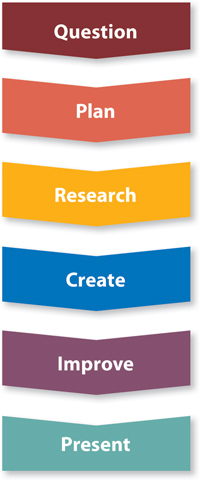Teaching the Process of Learning

We can't accomplish much in a second. Blink. Breathe. Take a step forward. We can do 60 times as much in a minute, and 3,600 times as much in an hour. Our truly great accomplishments come from combining the little things we do in seconds into long, complex processes that take days or weeks or months.
Learning is one such process. None of us is born walking, but one of us became Usain Bolt. None of us is born writing, but one of us became J.K. Rowling. They learned how to do what they do through a long, involved process. Whether training for an Olympic 100m race or beginning work on a new novel, people who are doing something difficult follow a similar process called inquiry.
What are the steps in the inquiry process?
The inquiry process consists of six steps that can help any novice become an expert in any discipline.

- Question: Learners first activate their prior knowledge, asking what they already know about a topic. Then they begin to probe more deeply in search of guiding questions: What does this mean? Why does this happen? How can it be changed? Questions open up room for learning.
- Plan: Learners then build a plan for answering their questions. They come up with a goal—what specifically they are trying to learn or do. They further define the goal by answering who, what, where, when, why, and how about it. They think about the tasks necessary to reach their goal, the time needed, and the team and tools available to them.
- Research: Learners next go out to gather the knowledge, skills, materials, and technology they need to reach their goals. In addition to traditional research in the library and online, this step can involve experimenting, interviewing, prototyping, and tinkering to find out what works and what doesn't.
- Create: After gathering knowledge and materials, learners assemble them into an initial product of some sort: essay, photo collage, model, structure, video, song, performance, machine. This stage involves synthesizing what learners have discovered to create something new.
- Improve: Once an initial product is created, learners need to reflect on it, evaluating what is working well and what could work better. Then they revise their work—adding, subtracting, reworking, and rearranging. The reiterative process between creating something and improving it results in a truly excellent product.
- Present: At some point in the process of creating and improving, the learner makes the decision to present the result to the world. Sometimes, this presentation simply entails handing in a paper for a grade. Better, richer experiences include implementing a solution to solve a real-world problem, or even running a winning 100m race.
Why should I teach the inquiry process?
The inquiry process is the key to learning. Think of your own life as an adult. Whenever you face a challenging situation or have to figure something out, you engage the inquiry process.
If you need to sell your home, you start by asking whether you should use a realtor or sell it yourself, what the benefits and drawbacks are for each approach, and who the best realtor might be. Then you make a plan and start your research. You create a description of the home, do last-minute repairs, clean the place from top to bottom, arrange for tours, and otherwise create the experience that will get your home sold. All the while, you pay attention to feedback, learn from your mistakes, make improvements, and eventually sell the place. All that is inquiry.
So, too, are most major tasks in our adult lives—finding a job, completing work assignments, getting a degree, finding a mate, raising children. . . . All are inquiry.
So, when you teach students the inquiry process, you equip them to learn in your class and throughout life. You also give them one of the keys to successful adulthood. They might even become the next Usain Bolt or J.K. Rowling.


Comments
Post new comment